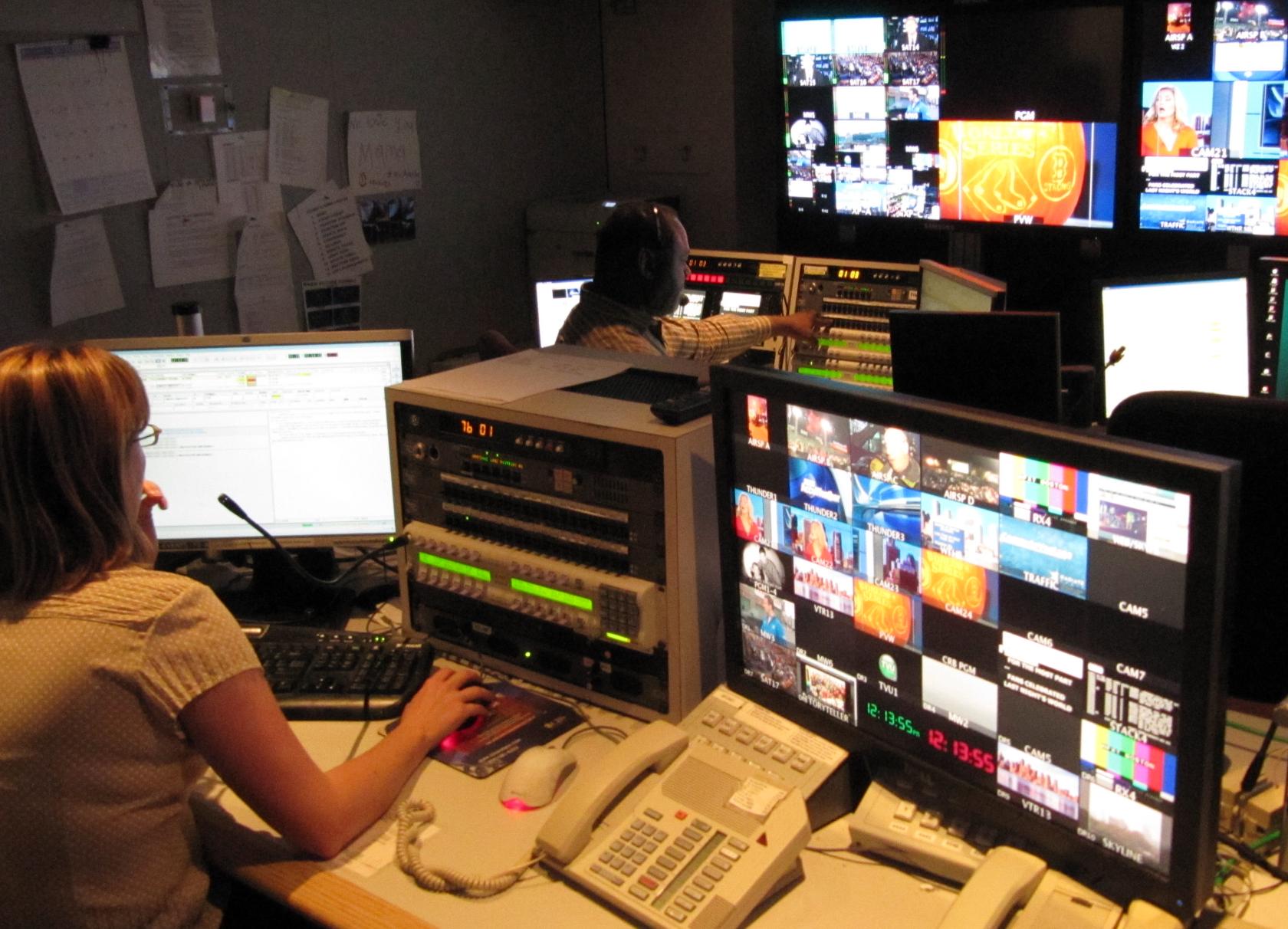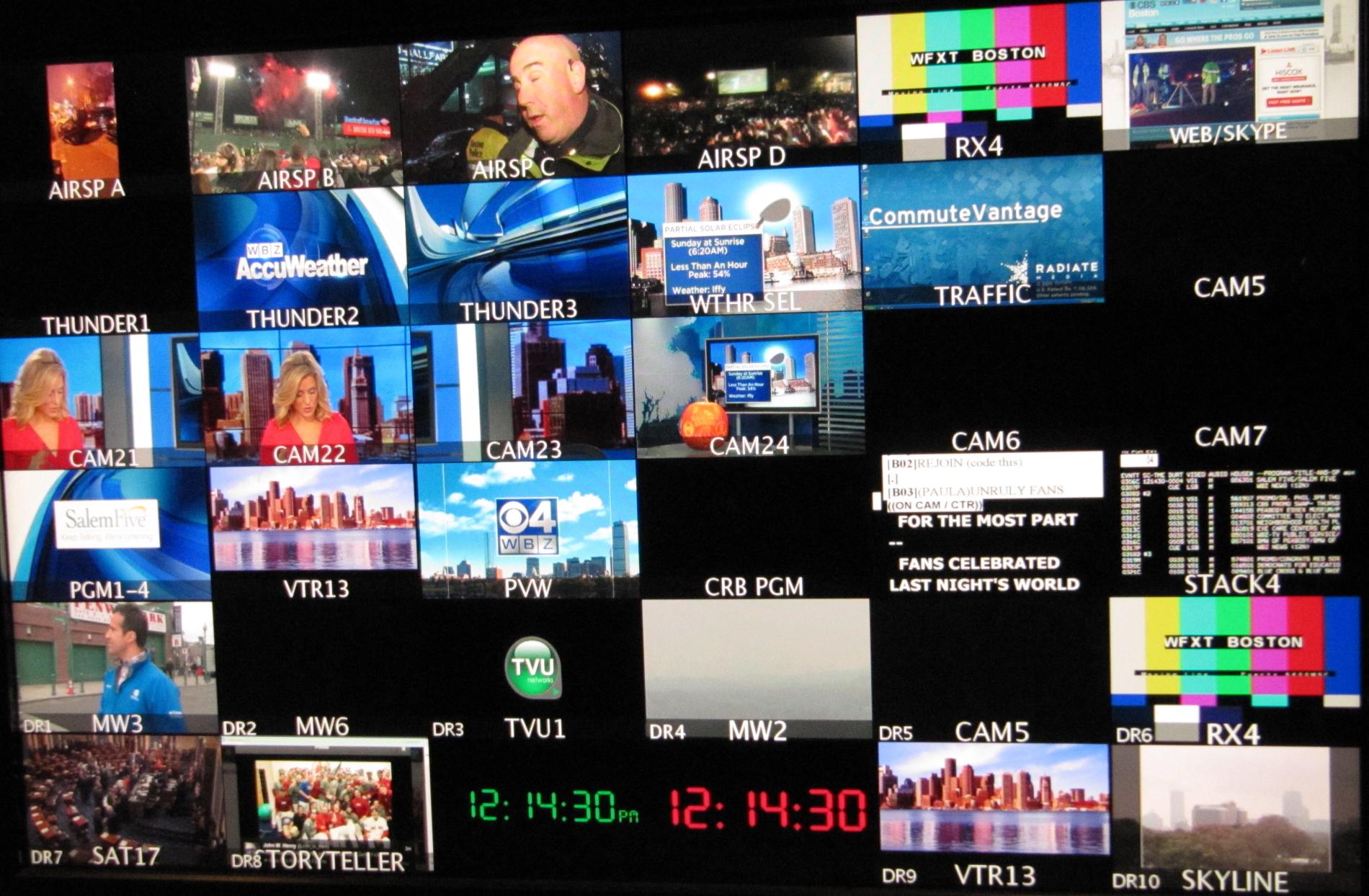 As I noted in my previous blog entry WBZ, two weeks ago (Halloween, October 31), Margie and I participated in a tour of the WBZ studios on Soldiers Field Road in Boston, Massachusetts. This tour was an activity sponsored by the Wayland Council on Aging, whose events are a benefit of getting older (although in general I'd say that getting older has more liabilities than benefits). I also noted in that entry that because I expressed an interest in the control room, our tour guide Mike Nosel took me there during the broadcast, while all the others in our group stayed in the studio. This entry is a report, with photos, of what I observed in the control room. I was surprised to find that the control room didn't overlook the studio. Over the years, I've seen many images on television of the classic TV control room overlooking the set of whatever show is being presented, with the director calling the shots from behind large soundproof glass windows. Although this control room was only a short walk away, it had no visual connection to the studio at all, other than that provided by the TV cameras. But upon reflection, a control room overlooking the studio might make sense for a television show where most of the material broadcast originates in the studio itself, such as a situation comedy, or a variety show such as Saturday Night Live. In a newscast, most of the material originates elsewhere - from off-site live feeds, and from pre-recorded sources. The anchor desk provides only a fraction of the material to be broadcast, and in some sense the least-important material. The anchor behind the desk isn't the story. Rather he or she is just the Master of Ceremonies. So the control room I visited overlooked nothing - yet, via audio/visual feeds, it overlooked everything. There were four people in the room, amid dozens of monitors (with many of the monitors displaying multiple windows). I was just a fly on the wall. I turned off my camera's flash and sound, took pictures, and observed quietly. In the left-front corner of the room sat the Director, who called the shots. Literally - he verbally called out switches from one video source to another. Here he is, the figure top-center in the photo, less illuminated by monitors than the person in the foreground:  You can click on any picture in this entry to enlarge it. With most browsers, you can then click again to enlarge it further. Return with your browser's "Back" button. The person who actually pushes the buttons to do the switching is the Technical Director, who sits at the front-right corner of the room. Here he is:  And here's the fourth person in the control room:  I'm afraid I didn't get the titles and exact roles of the two people in the rear of the room, but they seemed to be responsible for coordinating and lining up the various feeds that comprise the newscast. I assume one of them also controlled adjustments of the cameras, and had the ability to move the cameras, which have no in-studio operators, as I mentioned in my previous entry. I'm sure you've noted that everyone shown on the air in a newscast has an ear bud in his or her ear - it's mostly the people in the control room who are talking to them. And of course, those in front of the cameras wear microphones, so the communication is two-way. Everything in a television broadcast runs on a detailed schedule, laid out in advance, which gives the precise timing of every segment to be aired. It's of course particularly important for the advertisements to be fully run, since they're ultimately paying for the broadcast. And the show has to end exactly on schedule. In a live broadcast, of course, the precise schedule can't always be maintained. I'm not sure what happened in the newscast I was watching, but something slipped the schedule a bit, and an adjustment had to be made on the fly. Towards the end of the newscast, meteorologist Todd Gutner was told that he had to reduce his scheduled 12-second weather recap to 7 seconds. I'm not sure exactly what Todd did to accomplish this. Perhaps he shortened a sentence or two, or spoke a bit more rapidly, or a combination of both, but he finished in the allotted time. I'm sure the on-air talent gets very good at speaking for exactly the time assigned to them. Without any visible glitches, and without cutting anyone off, the newscast I watched ended precisely on schedule. Here's a picture of one of the monitors that displayed multiple possible video sources:  On the left side, you'll recognize anchor Paula Ebben in the newsroom, seen from two angles on CAM21 and CAM22, and two lines below her, David Wade on location at Fenway Park, seen in MW3. Obviously, since they're not looking at the camera, neither was on the air at the time (precisely 12:14:30 Eastern Daylight Time, as shown by the clocks at the bottom). To the right of Paula's images, CAM23 shows an empty seat at the news desk, not used during this broadcast with only one anchor. CAM24 shows the weather set, with Mike Nozel's Red Sox commemorative pumpkin in the foreground (a picture of it was included at the end of last week's blog entry, WBZ). As an engineer, and particularly as one who took a course called "Radio Workshop" in high school, I found watching this newscast from the control room to be fascinating. I discuss that high school course, and the view we got on our tour of the operation of a WBZ radio studio, in my next blog entry, called, of course, Radio Workshop.
  |